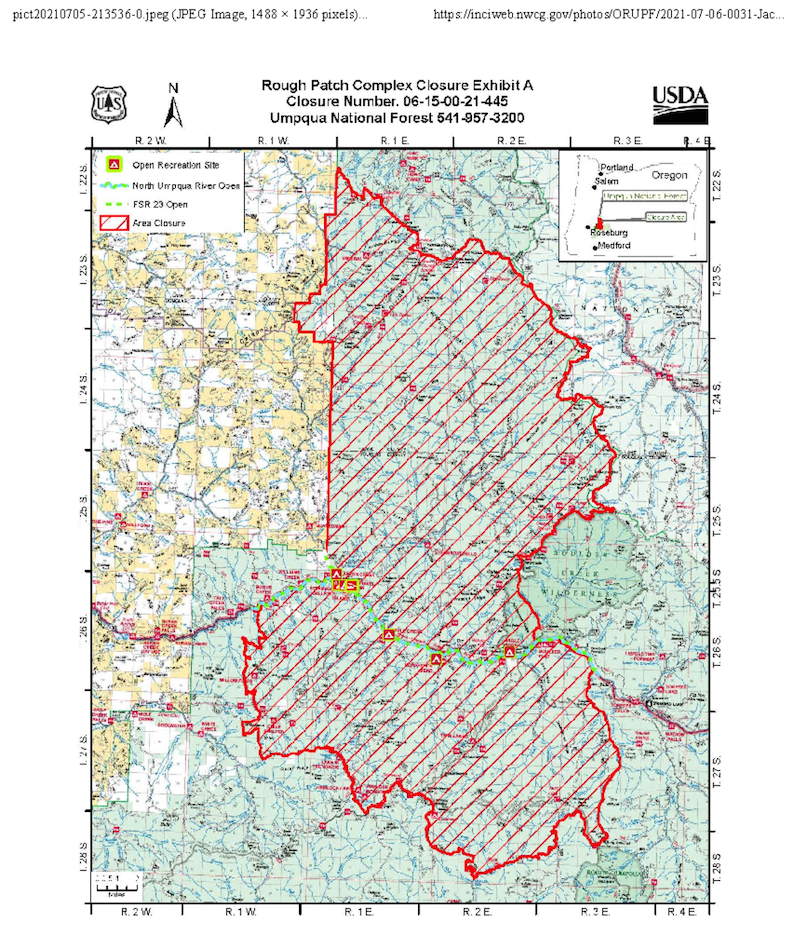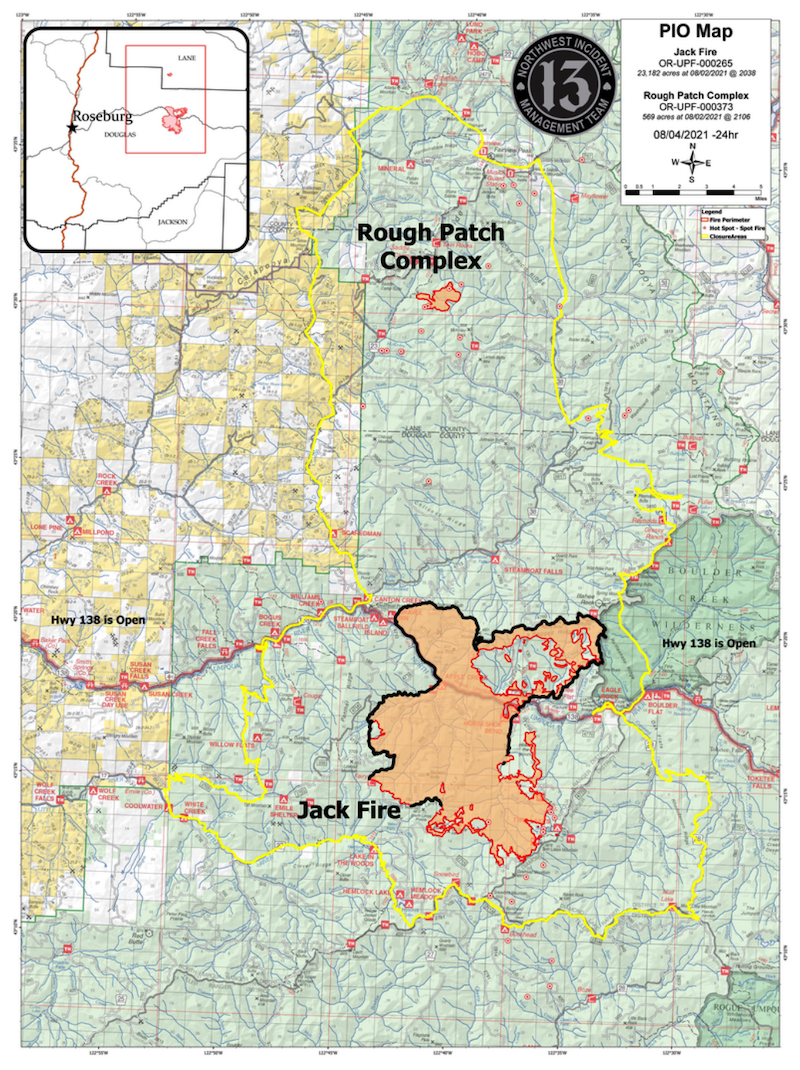FISHWATCH 2021 MONTHLY REPORT
July 2021
by Edward Kikumoto
Again this year, the U.S. Forest Service and The North Umpqua Foundation (TNUF) is asking the public to not visit the Pool due to Covid19 concerns, and to protect the health of the FishWatch Caretaker.
The opinions in this report are strictly my own, and do not reflect the views and opinions of the U.S. Forest Service, Oregon Department of Fish & Wildlife, or The North Umpqua Foundation.
Greetings from the Big Bend Pool FishWatch 2021 Caretaker.
My time at the Pool this month was limited to the first week of July because of the Jack Fire, and subsequently by the Rough Patch Complex fires (which were caused by lightning) at the end of the month, and continuing into August. (Explanation below.)
Statistics
No poaching activity, unlawful fishing, or harassment of the steelhead in the Pool observed in July (July 1 to July 5).
At the end of June there were, approximately, 25 steelhead in the Pool.
On July 5th (my last day at the Pool this month) there were, approximately, 50 steelhead in the Pool.
There were 11 visitors to the Pool while I was present at the Pool (July 1 to July 5), of which 7 visited on Saturday of the July 4th weekend.
I heard many vehicles slow down or stop momentarily before driving off.
I’m assuming that they saw the barrier at the entrance to the viewing area and decided not to stop and visit.
Reflections
July started with a slight cooling trend but became hot again over the July 4th weekend and continued through the entire month except for a few exception.
I can recall one early morning of light rain in July.
Water levels in the North Umpqua River, and Steamboat & Canton Creeks are at what I expect to be the lowest of the season.
I left the Pool, after spending the July 4th weekend at the Pool, on Monday, the 5th, at 13:40, to do chores at home.
Around 18:30, while at home at Steamboat, I was informed that there was a fire on Highway 138 about 3-miles upstream and that officials had shutdown access to Steamboat Creek Basin to the public so I could not return to the Big Bend Pool.
In addition they were recommending evacuation of all civilians from Steamboat.
The fire at that point was about 60-acres on very steep terrain.
I think these decisions were made in light of the extremely hot and dry conditions at the time, and memories of last year’s Archie Creek Fire, which blew up into a 100,000 acres conflagration in less than 2-days and came up to the perimeter of the Steamboat USFS/ODOT compound.
After a couple of days and a better sense of how the fire was evolving and reacting to environmental conditions (primarily wind direction), more official restrictions and closures were put in place.
During that first week of the fire I was given permission to go up to the Pool to secure the Airstream and on Friday, July 9, pulled the Airstream out of Steamboat Creek Basin (Basin).
What remains at the Pool are the 250-gallon propane tank and the two portable toilets.
Officials closed the Basin on Wednesday, July 7 to all public access, with the one exception for FishWatch, and it remained closed until Wednesday, July 28, when Steamboat Creek Road was reopened in its entirety with the closure still in place for the southern side of the Basin up to Big Bend Creek, which is closest to the Jack Fire.
The northern side of the Basin and above Big Bend Creek was reopened to public access.
HOWEVER, early in the morning of July 27 (note the timing here) lightning began striking the ridgeline above the northern side of the Basin 3-5 miles above Big Bend Pool, the very side that was reopened on July 28th.
On Friday, July 30, the CLOSED ROAD barriers went back up on Steamboat Creek Road.
I had hopes of taking the Airstream back to the Pool when I received permission from the Forest Service to do so on the 27th, and had scheduled the move for the 28th, only to have the move postponed because of the fires caused by the lightning strikes.
In three weeks the Jack Fire went from 60 acres to 23,000 acres, and was 75% contained, until the thunderstorms.
For more information: https://inciweb.nwcg.gov/incident/7605/
Here is an excerpt from the Inciweb Jack Fire 08.01.21 Daily Report regarding the fires caused by lightning strikes…
Inciweb – Jack Fire
https://inciweb.nwcg.gov/incident/article/7605/62507/
08.01.21 Daily Report Excerpt
Rough Patch Complex
“Multiple small fire starts have recently ignited in a remote location at the Upper Steamboat Creek Drainage, following lightning storms that passed through that vicinity. Management of these new fire starts north of the Jack Fire has been combined and named the Rough Patch Complex. There are approximately 22 new starts burning about 240 acres. As of 7:00 a.m. this morning, Northwest Team 13, under the leadership of Brian Gales, has assumed command of the Rough Patch Complex. Today the new resources for the Rough Patch Complex will be working on the 650 and 651 roads and scouting for potential containment lines and opportunities for suppression. Crews will be assisted by firefighters from the Umpqua National Forest and the Douglas Fire Protection Association. The Rough Patch Complex is burning in an area of limited access, narrow roads, steep terrain, and high fuel loads, which will present a challenge for suppression operations.”
In the evening on Sunday, August 1 a thunderstorm moved right over the Jack Fire and Rough Patch Complex Fire areas, which resulted in 15 additional lightning hotspots, causing both fires to get bigger, and reduced containment, particularly of the Jack Fire.
Fire is now ‘officially’ in the Steamboat Creek Basin.
This is the most recent Emergency Fire Closures Map dated 08.05.21, including all of Steamboat Creek Basin.

Water temperatures
With the high daytime temperatures I have been taking more frequent water temperature readings.
I have also been monitoring the high and low air temperatures.
Why the concern?
The science is, the higher the temperature the less oxygen in the water.
The general rule for North Umpqua wild summer steelhead is they are the most comfortable in water temperatures below 64ºF, they are severely stressed at 68ºF, and will die if trapped in water 70ºF and higher.
That is not to say that steelhead cannot survive at all in temperatures in the 70s, they can, but not well and not for extended periods of time.
And a mitigating factor may be whether the water is oxygenated or not, and whether the steelhead can find pockets of oxygenated water.
Acronyms
BBC Big Bend Creek (spring cooled water)
BBP Big Bend Pool (the Pool)
LBP Little Bend Pool (1/4 mile downstream)
SC Steamboat Creek
The “low” and “high” numbers are air temperatures.
All water temperature numbers are Fahrenheit.
07.01.21 Thursday
05:00 57ºF outside (low).
13:45 86ºF in the shade (today’s high).
14:00 BBC 62-64.
20:30 BBC 61-63.
07.03.21 Saturday
04:50 57ºF outside (low).
12:45 97ºF in the shade (today’s high).
13:00 BBC 60-62.
19:19 BBC 63-65.
19:28 SC above BBC 76-78.
19:39 Bottom of BBP 67-69.
07.05.21 Monday
Jack Fire started and Steamboat Creek Basin ‘unofficially’ closed.
Sightings
Ruffed grouse on the roadside as I was driving back and forth prepping the Airstream for its move out of the Basin.
Infrastructure
The refrigerator section of the Dometic refrigerator is not cooling.
According to the manufacturer this is common in ambient air temperatures in excess of 90ºF for this type of heat driven ammonia refrigerators.
The freezer section is working fine.
The only solution to the high air temperature problem is to install a fan(s) to increase airflow on the back of the unit.
I replaced the thermistor and installed a new refrigerator door latch.
I have ordered a 12-volt RV ventilation fan.
The Honda EU2200i and old Honda EU1000i are both working properly.
The portable toilets get cleaned once a month around mid-month.
They were cleaned on June 11.
I don’t know if they were cleaned in July due to the Jack Fire.
The cleaning schedule is sufficient for the one toilet I have reserved for my personal use.
The other toilet sees heavier use from weekend campers and folks out for the day, and swimmers.
I regularly check the public toilet to make sure that it is at least sanitary, and clean it when necessary.
Big Bend Pool Field Notes: What I observed when two people decided to cool their feet in Big Bend Creek.
From my June report…
“A brief explanation of “stress.”
One type of stress response, is to bunch up and go deep, and/or move as far away as possible from the source of stress, e.g., people being too close, otters and beavers in the pool – physical presence.
Another type of stress, which may be more extreme, is to mill around, somewhat as a body, and maybe even “daisy-chain,” which is to swim, as a body, in a tight circle, which I have witnessed only caused by something invisible in the water, e.g., human scent.
…No stress, to me, would be the steelhead spread out and holding, quite still, high in the water column (1-2 feet below the surface) in the lower half of the Pool (directly across from the viewing area) where the flow slows down.” (Underlining added for emphasis.)
What follows is a description of events that occurred sequentially and in proximity to each other, with an assumption on my part, that there is possibly a cause and effect relationship between these events.
My assumption is based on what I have heard from others about how steelhead and salmon may react to scents in the water that the fish may consider “threatening,” and may respond to in “stress” behavior, e.g., sticking one’s body part (or a bear paw) in the water above a school of fish and watching the fish go “crazy.”
On Saturday, July 3rd (July 4th weekend).
“12:10 …With the shade receding the fish are realigning and spreading out over the entire pool.”
About 12:45 I heard music slowly passing the Airstream as I sat in the shade of the Airstream awning.
I assumed that it was someone on a bicycle going by but was not sure in which direction.
“12:45 97F in the shade.”
At which point I decided to take temperature readings of Big Bend Creek.
At 12:55 I arrived at the Big Bend Pool just downstream of the bridge.
As I looked upstream I noted a young couple sitting less than knee deep in Big Bend Creek just upstream of the bridge.
I assumed that they must be the cyclists I heard passing by just a bit earlier.
I took my temperature readings, all the time wondering what effect these two people in the water were having on the steelhead in the Pool.
At 13:00 I hurried back to the Pool.
As I passed the upper part of the Pool, I could see that there were no steelhead holding in the upper or middle part of the Pool.
“13:00 …I found them at the very bottom milling and circling in the bottom half of the pool, in what appeared to be, in an agitated state.
They were not daisy chaining but close to it at times.
13:13 The steelhead seemed to be “calming down,” holding tightly together mid-pool on the bottom.
13:15 Just saw the couple ride away upstream.
13:30 …Steelhead still bunch[ed] in the lower end of the [Pool], in its deepest spot.
14:00 Steelhead have returned to their normal pattern.”
(TEXT in italics is from my FishWatch Daily Diary, edited for sense.)
What I saw were the steelhead swimming back and forth in a tight group between mid-pool (across from the viewing area) and the bottom shallows, almost in a figure eight pattern.
They would circle en mass once or twice at the bottom and then rapidly swim back upstream, abruptly turn around and head back downstream.
They did this about 4 to 6 times.
Individual steelhead would intermittently rollover just beneath the surface, in what has been described by others as a flashing motion.
They continued to do this for at least 10-minutes as I observed them.
Shortly thereafter the steelhead settled, tightly bunched, on the bottom in the deepest part of the Pool, which is almost directly across from the viewing area.
My thought, at the time was that whatever was disturbing them was no longer doing so, i.e., the people cooling themselves in Big Bend Creek had gotten out of the water.
I then walked up to the road and looked upstream to see them riding away headed upstream on the road.
A full 45-minutes after the couple rode away, the steelhead finally settled back into what I call their “no stress” pattern.
At no time during this sequence of events were the cyclists in sight of the steelhead, and they were over 150-feet away around the corner in Big Bend Creek.
No one else was around other than me, and I remained on the high ground above the Pool.
Whether the steelhead behavior can be described as agitated, panic, or stress is arguable…but it sure seemed like it, from my human perspective.
End of the FishWatch Monthly Report for July 2021.
Link: Jack Fire & Rough Patch Complex Fires
https://inciweb.nwcg.gov/incident/7605/
This is the link to the Jack Fire main page.
The map you see below is the Incident Overview map (PIO Map).
You need to go to the main page in order to get the most current version of the map.
The Big Bend Pool is at the intersection of 38 and 3818, and is 11-miles from Steamboat.
The closest lightning hotspot to the Pool is approximately 2-miles away (The Little Bend Creek Fire).
The fires between McKinley Rock and Saddle Camp Butte are approximately 10-miles away by crow fly.
The largest fire is the Chaos Fire.

